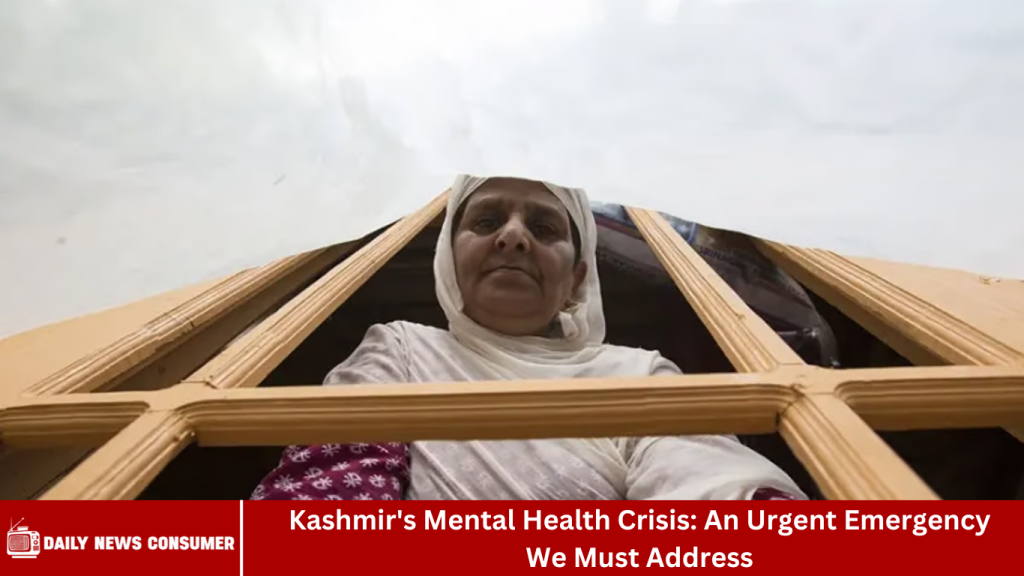Hi everyone! How are you all doing? Welcome to www.dailynewsconsumer.com! Kashmir, a region long embroiled in geopolitical conflict, is facing a silent but devastating crisis—mental health. Decades of violence, political instability, economic hardship, and social disruption have left deep psychological scars on its people. The situation has reached a point where mental health disorders are rampant, yet resources for treatment remain critically insufficient.
This article explores the root causes of Kashmir’s mental health emergency, its devastating impact, and the urgent steps needed to address it. Ignoring this crisis will only deepen the suffering of millions, making immediate intervention a moral and humanitarian necessity.
The Scale of the Crisis
1. Alarming Statistics
- According to a Medecins Sans Frontieres (MSF) report, nearly 1.8 million adults (45% of the population) in Kashmir show symptoms of mental distress, including depression, anxiety, and post-traumatic stress disorder (PTSD).
- A study by the Institute of Mental Health and Neurosciences (IMHANS), Kashmir, found that one in five Kashmiris suffers from PTSD.
- Suicide rates have surged, with over 500 reported cases in the last five years, many linked to untreated depression and trauma.
2. Why Is Kashmir’s Mental Health Crisis Unique?
Unlike other regions where mental health issues stem from socioeconomic factors alone, Kashmir’s crisis is deeply tied to:
- Chronic conflict and militarization – Frequent curfews, crackdowns, and violence create constant fear.
- Disappearances and loss of loved ones – Thousands of families live with unresolved grief.
- Economic instability – Unemployment and disrupted livelihoods exacerbate stress.
- Stigma around mental health – Many avoid seeking help due to shame or lack of awareness.
Root Causes of the Mental Health Emergency
1. Decades of Conflict and Trauma
Since the late 1980s, Kashmir has witnessed armed insurgency, military operations, and civilian unrest. Exposure to violence has led to widespread PTSD, depression, and anxiety disorders. Children growing up in conflict zones often develop behavioral issues and learning disabilities.
2. Internet Shutdowns and Social Isolation
Frequent communication blackouts (especially between 2019-2021) cut off Kashmiris from support systems, worsening feelings of isolation and helplessness.
3. Lack of Mental Health Infrastructure
- Severe shortage of psychiatrists – Only 0.2 psychiatrists per 100,000 people (WHO recommends 1 per 10,000).
- Few counseling centers – Most are concentrated in Srinagar, leaving rural areas underserved.
- Cultural stigma – Many associate mental illness with “weakness” or “madness,” preventing early intervention.
4. Economic Hardship and Unemployment
With unemployment at 15-20%, financial stress fuels anxiety and depression, particularly among youth.
The Human Cost: Stories from the Ground
Case Study 1: A Generation Scarred by Conflict
A 2022 survey by IMHANS found that 65% of schoolchildren in Kashmir exhibit symptoms of PTSD, including nightmares, hypervigilance, and emotional numbness. Teachers report increasing cases of anger outbursts and self-harm among students.
Case Study 2: The Suicide Epidemic
In 2023, a 25-year-old university student in Pulwama died by suicide, leaving a note citing “hopelessness.” His family had no idea he was struggling—highlighting the silent suffering many endure.
What Needs to Be Done?
1. Expanding Mental Health Services
- Train more psychiatrists and counselors – Government must invest in mental health education.
- Mobile mental health clinics – To reach remote villages.
- School-based counseling programs – Early intervention for children.
2. Community Awareness and Destigmatization
- Public campaigns to normalize mental health discussions.
- Involvement of religious leaders to counter myths about mental illness.
3. Policy Interventions
- Include mental health in primary healthcare – As recommended by the National Mental Health Policy.
- Regulate sedative misuse – Overprescription of benzodiazepines is a growing problem.
4. Economic Rehabilitation
- Job creation programs to reduce stress linked to unemployment.
- Support for conflict-affected families – Financial aid and trauma counseling.
Frequently Asked Question
How widespread is mental illness in Kashmir?
Studies suggest 45% of adults have significant mental distress, with PTSD, depression, and anxiety being the most common.
Why is suicide increasing in Kashmir?
Factors include untreated depression, trauma from conflict, unemployment, and lack of mental health support.
Are there enough mental health professionals in Kashmir?
No. Kashmir has less than 50 psychiatrists for a population of over 12 million, far below WHO standards.
How do internet shutdowns affect mental health?
They increase isolation, disrupt access to telemedicine, and worsen anxiety by cutting off communication.
What role does stigma play in worsening the crisis?
Many avoid seeking help due to fear of being labeled “crazy,” leading to untreated conditions.
Can mental health be improved without resolving the political conflict?
While political stability would help, immediate steps—better healthcare, counseling, and awareness—can still save lives.
How can ordinary people help?
- Educate themselves and others about mental health.
- Support NGOs working in Kashmir (e.g., MSF, IMHANS).
- Advocate for policy changes to improve mental health funding.
Conclusion
Kashmir’s mental health crisis is not just a public health issue—it’s a humanitarian emergency that demands immediate and sustained action. Decades of conflict, political instability, and social unrest have left deep psychological scars on the region’s population, with alarming rates of PTSD, depression, and anxiety, particularly among youth. Despite this, mental health services remain scarce, underfunded, and stigmatized. Addressing this crisis requires a multi-faceted approach: expanding access to mental health care, training professionals, breaking societal taboos, and integrating psychological support into broader healthcare and community initiatives. Ignoring this silent epidemic will only deepen the trauma. Now is the time to act—not just with sympathy, but with strategy, funding, and unwavering commitment to the well-being of Kashmir’s people.

